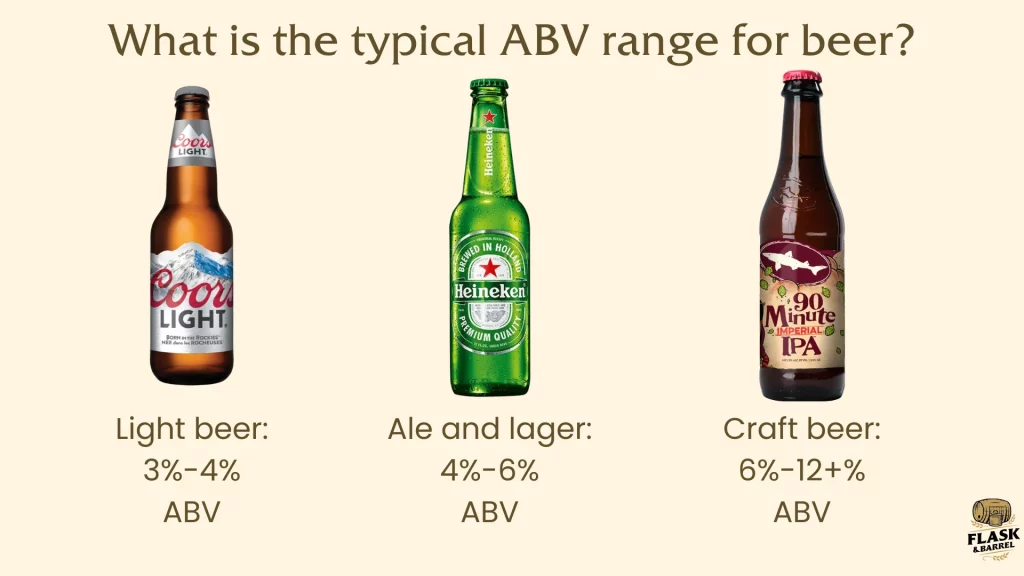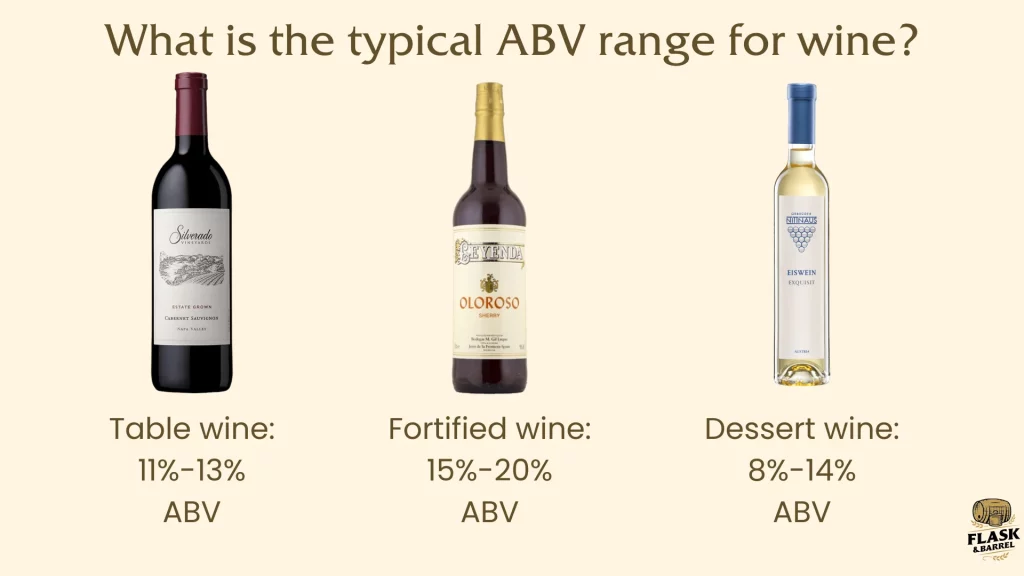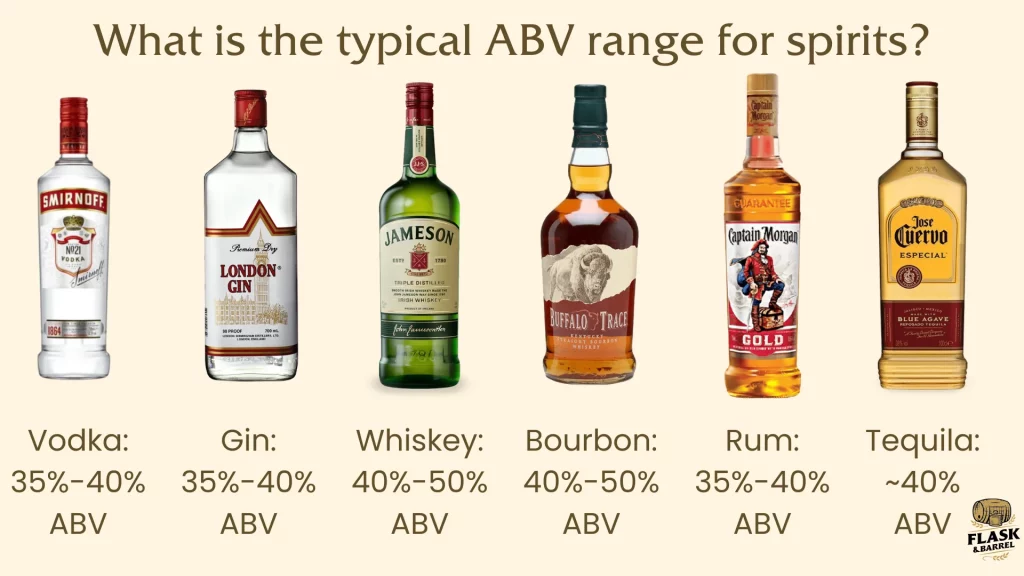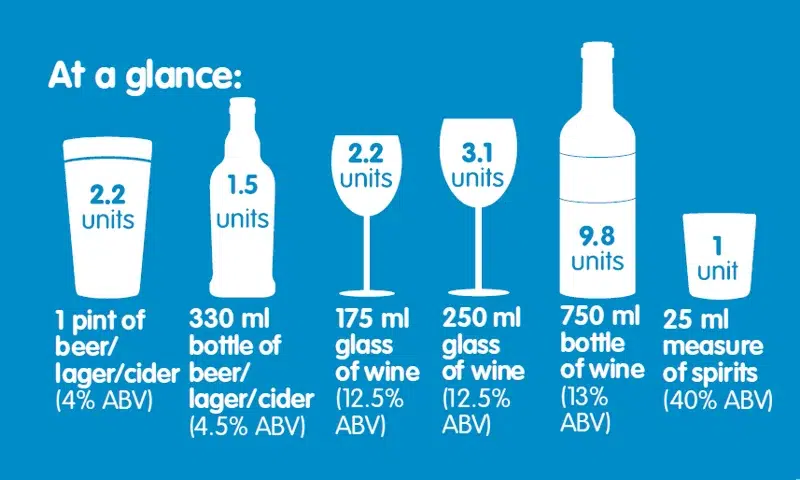Alcohol By Volume (ABV) is a pivotal metric, universally acknowledged for measuring the alcohol content in beverages. By providing a clear, quantifiable indicator of potency, ABV empowers individuals to make informed choices about their alcohol consumption. This guide delves into the significance of ABV, from aiding legal compliance and understanding beverage strength to facilitating the comparison of diverse alcoholic drinks. With a focus on beers, wines, and spirits, we unravel how ABV is calculated, exploring the roles of fermentation and distillation, and outline the typical ABV ranges across these categories. Whether you’re a casual drinker curious about the strength of your pint, a connoisseur comparing the nuances of vintage wines, or someone navigating the world of spirits, a comprehensive understanding of ABV is invaluable. It not only enriches your drinking experience but also promotes a culture of responsible alcohol consumption.
What is ABV?
ABV, short for Alcohol By Volume, is a standard measurement expressed as a percentage to denote the concentration of alcohol in an alcoholic beverage. This crucial figure tells you exactly how much of a drink is composed of alcohol, offering a straightforward way to gauge its strength. For instance, a beverage with an ABV of 5% contains 5% alcohol by volume. This universal metric not only facilitates a better understanding of what one is consuming but also aids in comparing the alcohol content across different types of beverages, from beers and wines to spirits. Understanding ABV is essential for responsible drinking, allowing consumers to monitor and manage their alcohol intake effectively.
Why is ABV important?
ABV’s significance extends beyond a mere number; it serves as a fundamental guide for several reasons. Firstly, it is crucial for adhering to legal drinking limits, ensuring both consumers and producers comply with regulations. Secondly, ABV is instrumental in understanding alcohol strength; it provides a clear metric to gauge how potent a beverage is, impacting consumption choices and promoting moderation. Lastly, ABV aids in comparing different alcoholic beverages, offering a uniform scale to measure and contrast the alcohol content across various drinks. This comparison is not just about strength but also about appreciating the diversity in flavor, tradition, and craftsmanship that different alcohol percentages can signify. Understanding ABV helps consumers make informed decisions, fostering a responsible and enriched drinking culture.
For legal drinking limits
ABV is a key factor in enforcing legal drinking limits. By providing a clear measure of alcohol content, it helps ensure that both consumers and producers adhere to the laws and regulations governing alcohol consumption. This not only promotes safety but also legal responsibility. For example, knowing the ABV of a beverage can help a person decide whether they’re within their limit to drive safely after social drinking.
For understanding alcohol strength
Understanding the alcohol strength of a beverage is made straightforward with ABV. It allows individuals to gauge how strong a drink is, enabling them to make informed decisions about their consumption. This knowledge is crucial for moderating intake and promoting a culture of responsible drinking. For instance, someone may choose a lower ABV beer (e.g., 4%) over a higher ABV craft beer (e.g., 9%) during a social event to enjoy the gathering without overindulging.
For comparing different alcoholic beverages
ABV also plays a pivotal role in comparing different alcoholic beverages. It offers a standardized metric for assessing the alcohol content across a wide range of drinks. This comparison is invaluable for consumers looking to explore the vast landscape of alcoholic beverages, understanding the nuances that different alcohol levels bring to the taste and experience of each drink. For example, a wine enthusiast might compare the ABV of a table wine (around 12%) to that of a fortified wine (up to 20%) to anticipate the difference in potency and flavor profile, aiding in their selection process for pairing with a meal.
Incorporating these specific examples and scenarios into the discussion on the importance of ABV provides readers with tangible insights into how ABV can influence choices in various social and legal contexts, further emphasizing the value of understanding alcohol by volume in promoting responsible and enjoyable drinking experiences.
How is ABV calculated?
The calculation of ABV (Alcohol By Volume) is deeply intertwined with the processes of fermentation and distillation. During fermentation, yeast transforms sugars into alcohol and carbon dioxide, establishing the foundational alcohol content of the beverage. This stage is critical as it sets the base level of alcohol that can be further concentrated through distillation. In the distillation process, alcohol is separated from the mixture by heating, leveraging the fact that alcohol evaporates at a lower temperature than water. This method can significantly elevate the alcohol content, resulting in spirits with a higher ABV compared to fermented beverages like beer and wine.
The precise measurement of ABV involves calculating the volume of alcohol present in a specific volume of liquid, yielding a percentage that accurately reflects the beverage’s alcohol strength. This scientific methodology ensures both accuracy and consistency, empowering consumers with the knowledge of exactly what they are consuming.
The role of fermentation
Fermentation is the foundational step in alcohol production, where yeast converts sugars into alcohol and carbon dioxide. This natural process sets the initial alcohol content for beverages, with the extent of fermentation influencing the final ABV. It’s a delicate balance, as different yeast strains and fermentation conditions can lead to varying levels of alcohol, shaping the character and strength of beers and wines.
The distillation process
Distillation takes the alcohol content established by fermentation to a higher level. By heating the fermented liquid, alcohol is evaporated and then condensed, separating it from water and other components. This process can be repeated to increase purity and alcohol concentration, resulting in spirits with a significantly higher ABV. Distillation allows for the creation of a diverse range of spirits, each with its unique strength and flavor profile.
Calculating ABV
The ABV of a beverage is calculated using the following formula:
[ \text{ABV (%)} = \left( \frac{\text{Volume of Alcohol}}{\text{Total Volume of Liquid}} \right) \times 100 ]
For example, if you have a 500ml bottle of beer and 25ml of that is pure alcohol, the calculation would be:
[ \text{ABV (%)} = \left( \frac{25ml}{500ml} \right) \times 100 = 5% ]
This formula provides a straightforward way to understand the alcohol content of any beverage, allowing consumers and producers alike to gauge the strength and potency of alcoholic drinks accurately.
What is the typical ABV range for beer?
The ABV range for beer typically spans from as low as 3% to upwards of 12%, encompassing a wide variety of styles and flavors. Light beers often sit at the lower end of this spectrum, offering a more refreshing and less intoxicating experience. On the other hand, ales and lagers represent the middle ground, with ABVs that cater to traditional beer drinkers seeking a balance of flavor and potency. Craft beers, known for their innovation and diversity, can venture into higher ABV territories, sometimes exceeding the 12% mark. These beers often emphasize complex flavors and unique brewing techniques, appealing to enthusiasts looking for a distinctive drinking experience. This range demonstrates beer’s versatility as a beverage category, capable of satisfying a broad spectrum of preferences and occasions.

Light beers
Light beers are characterized by their lower alcohol content, typically ranging between 3% to 4% ABV. Designed for easy drinking, they offer a crisp and refreshing taste, making them a popular choice for casual drinking occasions or for those seeking a less intoxicating option.
| Brand | ABV | Description |
|---|---|---|
| Bud Light | 4.2% | A light lager with a clean, crisp taste. |
| Coors Light | 4.2% | Known for its cold-filtered brewing process. |
| Miller Lite | 4.2% | A light beer that doesn’t compromise on taste. |
Ales and lagers
Ales and lagers represent the heart of the beer world, with ABV values generally spanning from 4% to 6%. Ales are known for their rich and varied flavors, while lagers are prized for their smooth and clean profiles. This range allows for a diverse array of beer experiences, catering to traditional tastes and preferences.
| Brand | ABV | Description |
|---|---|---|
| Sierra Nevada Pale Ale | 5.6% | A classic American pale ale, known for its piney and grapefruit aromas. |
| Heineken | 5.0% | A widely popular lager with a slightly bitter taste. |
| Guinness Draught | 4.2% | A smooth, creamy stout with a unique nitrogenated body. |
Craft beers
Craft beers push the boundaries of conventional brewing, often featuring ABVs that range from 6% to 12% or higher. These beers are celebrated for their innovative flavors and brewing techniques, appealing to enthusiasts and connoisseurs alike. The higher ABV in craft beers is usually accompanied by a more complex and robust flavor profile, offering a unique and memorable drinking experience.
| Brand | ABV | Description |
|---|---|---|
| Dogfish Head 90 Minute IPA | 9.0% | A continuously hopped imperial IPA with a great malt backbone. |
| Stone Imperial Russian Stout | 10.5% | A bold stout with rich flavors of chocolate and coffee. |
| The Alchemist Heady Topper | 8.0% | A highly sought-after double IPA known for its hoppy complexity. |
This detailed breakdown with specific examples and their ABVs provides a practical guide for readers, making the information more relatable and serving as a useful reference for exploring different beer styles and their strengths.
What is the typical ABV range for wine?
Wine, with its rich history and diverse styles, typically has an ABV range from 8% to 15%. Table wines, which include the majority of reds, whites, and rosés, generally fall within the 11% to 13% ABV range, offering a balance between flavor and alcohol content that appeals to a wide audience. Fortified wines, such as port and sherry, have a higher alcohol content, usually between 15% to 20% ABV, achieved by adding distilled spirits to the wine. This process not only increases the alcohol level but also contributes to the wine’s body and flavor complexity. Dessert wines, on the other hand, can vary widely in alcohol content, typically ranging from 8% to 14% ABV, depending on the production method and the desired sweetness level. The ABV in wines is a reflection of the winemaking process, including fermentation and fortification, and plays a crucial role in defining the character and style of the wine.

Table wines
Table wines, encompassing most red, white, and rosé varieties, typically have an ABV ranging from 11% to 13%. This moderate alcohol content strikes a balance, making these wines suitable for a variety of occasions and meals. They reflect the traditional winemaking processes where the natural fermentation of grapes determines the alcohol level.
| Wine Type | ABV Range | Examples |
|---|---|---|
| Red Table Wine | 12% – 14% | Cabernet Sauvignon, Merlot |
| White Table Wine | 11% – 13% | Chardonnay, Sauvignon Blanc |
| Rosé Wine | 11% – 13% | Provence Rosé, Pinot Noir Rosé |
Fortified wines
Fortified wines, such as port, sherry, and Madeira, see their alcohol content elevated to 15% to 20% ABV through the addition of distilled spirits. This not only boosts their alcohol level but also enhances their flavor profile and shelf life. Fortified wines are known for their rich tastes and are often enjoyed as aperitifs or with dessert.
| Wine Type | ABV Range | Examples |
|---|---|---|
| Port | 19% – 22% | Tawny Port, Ruby Port |
| Sherry | 15% – 22% | Fino Sherry, Oloroso Sherry |
| Madeira | 18% – 20% | Malmsey Madeira, Sercial Madeira |
Dessert wines
Dessert wines vary widely in ABV, typically ranging from 8% to 14%. Their alcohol content depends on the specific winemaking technique used, such as late harvest, ice wine production, or the addition of spirits. These wines are characterized by their sweetness and are designed to complement the final course of a meal.
| Wine Type | ABV Range | Examples |
|---|---|---|
| Late Harvest | 8% – 12% | Late Harvest Riesling, Late Harvest Chenin Blanc |
| Ice Wine | 9% – 13% | Canadian Ice Wine, German Eiswein |
| Moscato | 5% – 7% | Moscato d’Asti, Sparkling Moscato |
This detailed breakdown with specific examples and their ABVs provides a practical guide for readers, making the information more relatable and serving as a useful reference for exploring different wine styles and their strengths.
What is the typical ABV range for spirits?
Spirits, known for their higher alcohol content compared to beer and wine, typically boast an ABV range from 35% to 50%. This category includes a diverse array of beverages, each with its unique distillation process and flavor profile. Vodka and gin often sit at the lower end of the spectrum, providing a versatile base for cocktails with their relatively neutral flavors. Whiskey and bourbon occupy the mid to high range, offering rich, complex flavors that are savored by enthusiasts. Rum and tequila can vary widely within this range, reflecting the diversity of styles and production methods within these categories. The high ABV of spirits is a result of the distillation process, which concentrates the alcohol content, leading to more potent beverages that are typically consumed in smaller quantities.

Vodka and gin
Vodka and gin are spirits that generally have an ABV ranging from 35% to 40%. Vodka is celebrated for its clarity and purity, offering a versatile base for a myriad of cocktails. Gin, infused with botanicals like juniper, lends a distinctive flavor that is both refreshing and complex. Their relatively lower ABV makes them accessible and adaptable to various drinking preferences.
Whiskey and bourbon
Whiskey and bourbon typically feature ABVs between 40% to 50%, embodying a spectrum of rich and intricate flavors. Whiskey, with its diverse types including Scotch and Irish, offers a wide range of taste profiles from smoky to sweet. Bourbon, a type of American whiskey, is known for its caramel and vanilla notes, deriving its character from the charred oak barrels in which it is aged. These spirits are often enjoyed neat or with minimal dilution to appreciate their full flavor.
Rum and tequila
Rum and tequila span a broad ABV range, reflecting the variety within these categories. Rum, which can vary from 35% to 40% ABV, is made from sugarcane byproducts and is distinguished by its sweet and fruity to rich and molasses-like flavors. Tequila, distilled from the agave plant, typically has an ABV of 40%, offering flavors from crisp and herbal to deeply complex when aged. Both spirits are integral to numerous classic and innovative cocktails, highlighting their versatility and appeal.

